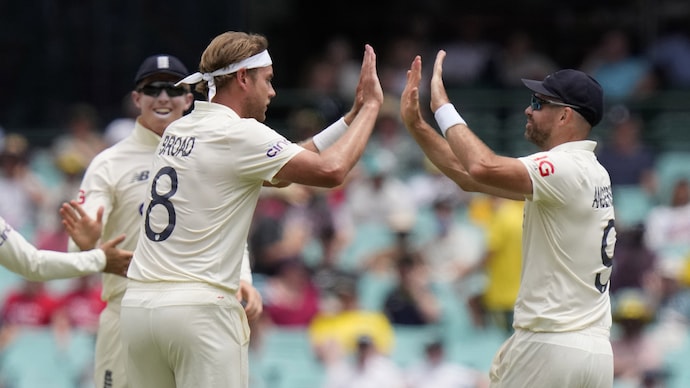
There might soon be an end to hunting in pairs. Enjoy this duopoly for the time being, though.
Many things make Sydney Gregory memorable. He played in Sydney’s first Test in 1894–1895 and, more importantly, he holds the record for the most Ashes Tests played—52—having been born on the current site of the Sydney Cricket Ground. Gregory was a skilled run-getter, but his Wisden obituary also praised him for his outstanding cover-point skills.
However, he wasn’t a bowler. You must skip 15 rows before Shane Keith Warne, who has 36 Test appearances to his credit, appears to find a pure bowler on that illustrious list rather than a part-timer who simply rolled over his arm in the days before World War I. James Anderson and Stuart Broad, who have each played 35 Ashes Tests, are listed below his name, side by side.
Anderson and Broad are ready to play their ninth Ashes together after combining for 1,017 wickets in 134 Test matches.
And they are still not finished.We are already aware of the trivia surrounding Anderson, 40, and Broad, 36, cricket’s most renowned and enduring pace bowling pair with 1,017 wickets in 134 Tests, set to compete in their ninth Ashes series, etc. , etc. , — the list is likely to be extensive.
Another way to show the perseverance and will of two modern greats is that it took them 15 years to win one Test, compared to Warne’s 14-year requirement. The final series for them might be an Ashes at home. However, England won’t care if it isn’t.
For the record, the most successful fast bowling team in cricket is not Anderson and Broad. Eight wickets were taken on average per game by Curtly Ambrose and Courtney Walsh. Dennis Lillee and Jeff Thomson averaged 8 points per test despite only playing 26 tests together.
Malcolm Marshall and Michael Holding performed marginally better, averaging 8 points in wickets per game. Nobody even came close to Wasim Akram and Waqar Younis, who dismissed 559 batsmen while averaging 9 point 16 wickets per game.
In terms of longevity, Anderson and Broad may have outperformed each of them, allowing modern cricket to hold on to a long-cherished aspect of red-ball cricket: a great bowling pair. Couples have been used in modern cricket. Even though they are a compelling duo, Pat Cummins and Mitchell Starc haven’t bowled together for very long.
Prior to Jasprit Bumrah’s back injury, he and Mohammed Shami were dating. Trent Boult, Tim Southee, Anderson, and Broad are the only remaining hunters in pairs, and it’s frightening to think that they might become extinct in a few years.
Modern fast bowling’s most thrilling performances no longer venture into red-ball cricket. A franchise contract for the entire year has reportedly been extended to Jofra Archer. Instead of concentrating on bowling 10 balls of good length on the fourth stump, more and more pacers are leaning toward improving their abilities in accordance with T20 norms. We encourage a rapid pace. However, bowlers who can also hit a six or two are more fashionable.
Boult’s example shows that changing formats to maintain one’s position in the central contracts is no longer a top priority. Until he burned out, Bumrah was an exception. But Anderson and Broad maintain their poise.
It wasn’t simple to come to this happy conundrum. Regarding the reasoning behind rotating Anderson and Broad when they only play one format, concerns have been raised, the majority of which are pertinent. But few initially grasped the deeper intention.
One drawback of possessing a bowling pair that is exceptional only once in a generation is the complacency it can cause, leading a team to believe that they will stay on until their replacements magically fill their shoes overnight.
All major teams have eventually encountered this issue. However, after Anderson and Broad had been subtly phased out of white-ball cricket, Andrew Strauss and later Rob Key, the former and current directors of cricket for England, decided to think outside the box.
Simple: build an attack around them while saving them for the most crucial games. The rotational policy. Following his exclusion from the West Indies tour in 2022, Broad didn’t take it well and came close to retiring.
But he changed, and he did so without being particularly aware of it. Of course, having Anderson as your partner has advantages, like long sessions of bowling at the nets. They were able to focus on the only job they were given—bowling with the red ball—after clearing their minds, in addition to clearing their minds. Age brought refinement and the ability to identify a batter’s weakness earlier than other people.
Because of this, Broad had Warner covered in the 2019 Ashes, removing him from the game seven times out of ten. The accuracy of Anderson’s spells left batters, his teammates, and the audience in awe of his ability to drastically change the course of a game with the smallest adjustment to wrist position or scrambling the seam at the last second.
The administrative agreement that they must not be disturbed also helped them to thrive in the high art of seam bowling. Due to this, they are not required to play in the IPL or learn any T20 strategies or shots.
This was one of the few things England got right for a nation that appears to be so focused on honing their white-ball motto while attempting to redefine Test cricket.
Get the latest cricket news here, like us on Facebook, and follow us on Twitter and Instagram for more such updates













